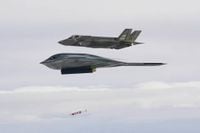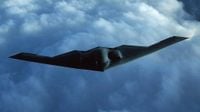The skies above the Norwegian Sea crackled with anticipation in early September 2025 as a U.S. Air Force B-2 Spirit stealth bomber, freshly departed from Whiteman Air Force Base in Missouri, joined up with Royal Norwegian Air Force F-35 Lightning IIs for a groundbreaking exercise. The mission? To put the U.S. Air Force Research Laboratory’s QUICKSINK maritime weapon system through its paces in a real-world setting, showcasing not just military might but also the deepening cooperation between the United States and its Norwegian allies.
According to gCaptain, the test unfolded on September 3, 2025, as part of the Air Force Research Laboratory QUICKSINK Joint Capability Technology Demonstration. The operation saw the B-2 Spirit—one of the world’s most advanced stealth bombers—integrate seamlessly with Norwegian F-35s to execute a long-range strike against a surface vessel. The bomber carried and deployed the 500-pound GBU-38 Joint Direct Attack Munition (JDAM), a precision-guided bomb, to engage and sink the maritime target in the Norwegian Sea.
“This test is a clear example of how we work with trusted allies to bring new capabilities into play faster and smarter,” said Col. Scott Gunn, commander of the 53rd Wing, in a statement released by the U.S. Air Force. “We’re not just preparing for tomorrow; we’re shaping it together.” That sentiment was echoed by Lt. Col. Stephen Bressett, commander of the 72nd Test and Evaluation Squadron, who added, “We are building readiness on both sides of the Atlantic and creating options that make maritime strike more distributed, survivable and integrated.”
The collaboration between the U.S. and Norway was more than symbolic. Norwegian support was critical, providing infrastructure and airspace access that enabled the test to take place in a region of increasing strategic importance. As reported by the National Security Journal, the Royal Norwegian Air Force hosted the event, validating not only the interoperability of allied forces but also advancing realistic tactics in Northern European conditions. The exercise also highlighted the importance of allied partnerships at a time when NATO’s northern flank has grown more pivotal amid ongoing Russian aggression and as Norway, Sweden, and Denmark deepen their support to Ukraine.
The QUICKSINK weapon system itself represents a significant leap in maritime strike capability. Developed as a joint effort among the Air Force Materiel Command’s Air Force Research Laboratory, the Air Force Test Center, and Air Combat Command’s 53rd Wing, QUICKSINK transforms traditional air-to-surface munitions into precision anti-ship weapons using modular seeker technology. This allows for cost-effective upgrades—turning so-called “dumb” bombs into “smart” ones for under $100,000 each, a bargain compared to the $1.4 million price tag of a Harpoon missile or the $3 million cost of an AGM-158C Long Range Anti-Ship Missile (LRASM), as highlighted by The National Interest.
The 500-pound QUICKSINK variant used in the Norwegian Sea exercise is just one option in a growing arsenal. The system also comes in larger variants, such as the 2,000-pound ordnance used by a B-2 Spirit to sink the decommissioned USS Dubuque during the 2024 Rim of the Pacific (RIMPAC) SINKEX. This flexibility gives commanders a range of options for engaging maritime threats, whether from stealth bombers like the B-2 or multirole fighters such as the F-15E Strike Eagle and F-16 Fighting Falcon.
“QUICKSINK offers an affordable, game-changing solution to rapidly and efficiently sink maritime targets,” said Col. Dan Lehoski, also of the 53rd Wing, in remarks reported by the National Security Journal. The weapon’s modular design is built on the Air Force Research Laboratory’s Weapon Open Systems Architecture (WOSA), which allows for the integration of components from different manufacturers and helps keep costs down—an important consideration as military budgets face increasing scrutiny.
But the significance of the test went beyond hardware. The exercise advanced tactics for long-range sensor-to-shooter operations, integrating beyond-line-of-sight communications and multi-domain targeting capabilities. These are essential skills in modern, contested environments where traditional anti-ship weapons like torpedoes require submarines to expose their positions, whereas air-delivered strikes can be launched across vast distances at a much higher tempo.
The B-2 Spirit, introduced in 1993 and still one of the world’s most formidable bombers, was a fitting platform for the demonstration. With a wingspan of 172 feet, a maximum takeoff weight of 336,500 pounds, and a range of 6,000 nautical miles without aerial refueling, the B-2 can deliver up to 40,000 pounds of ordnance—including both conventional and nuclear weapons—while remaining virtually invisible to enemy radar. Its stealth, range, and payload flexibility were all on display during the Norwegian Sea mission, underlining why the aircraft remains a cornerstone of U.S. strategic deterrence.
The September 2025 test was not the first time the QUICKSINK system had been put to the test. Previous exercises included a June 2025 deployment at Eglin Air Force Base Gulf Test Range in Florida, as well as tests in 2022 and 2024, and the aforementioned RIMPAC SINKEX in July 2024. Each iteration has refined the system’s capabilities and expanded its operational envelope, with the Norwegian Sea test marking a new milestone in allied cooperation and operational realism.
The geopolitical context of the exercise cannot be ignored. As NATO’s Secretary General Mark Rutte noted in a statement last month, “Since the earliest days of Russia’s full-scale invasion, Denmark, Norway, and Sweden have been steadfast in their support for Ukraine.” Norway’s role as a founding member of NATO, and its recent collaboration with Sweden and Denmark to fund a $500 million package of equipment and munitions for Ukraine, underscores the region’s heightened strategic significance. With Russian drones reportedly landing in Poland and tensions simmering across Northern Europe, the ability to conduct distributed, survivable, and integrated maritime strikes has never been more relevant.
Yet, even amid this military cooperation, the U.S. and Norway have found themselves at odds over unrelated issues, such as Norway’s sovereign wealth fund’s recent decision to divest from U.S. construction giant Caterpillar—a move that drew sharp criticism from American officials. Still, as Norwegian Finance Minister Jens Stoltenberg pointed out, “U.S. authorities are well aware of the rules surrounding the Norwegian sovereign wealth fund and its ethics guidelines,” according to Reuters. Such diplomatic bumps have not derailed the military partnership, which remains robust and forward-looking.
Looking ahead, the successful demonstration of the QUICKSINK system in the Norwegian Sea opens new operational theaters for both the U.S. and its allies. It validates the concept of affordable, flexible, and precise maritime strike capabilities that can be rapidly deployed in response to emerging threats. As Col. Gunn aptly put it, “We’re not just preparing for tomorrow; we’re shaping it together.”
In a world where strategic advantage can hinge on the ability to adapt and innovate, the U.S.-Norwegian QUICKSINK exercise stands as a testament to the power of allied cooperation and technological ingenuity. The message is clear: when it comes to defending the world’s seas, tomorrow’s solutions are already taking flight.





